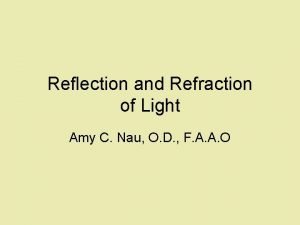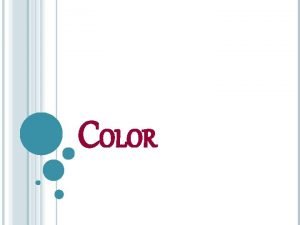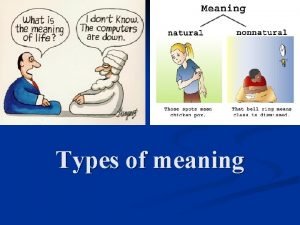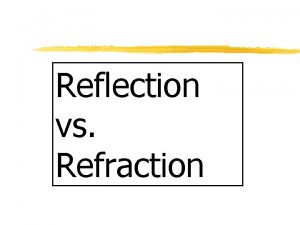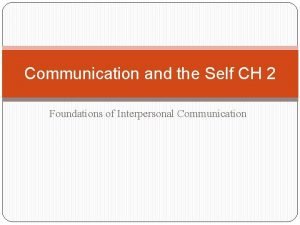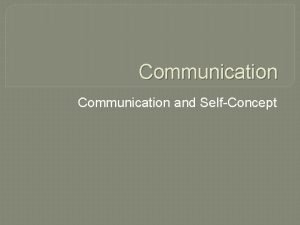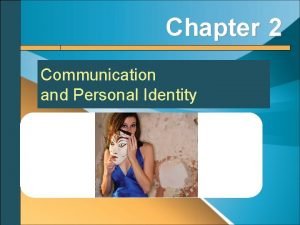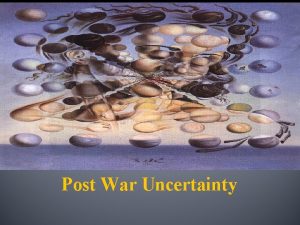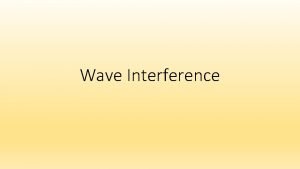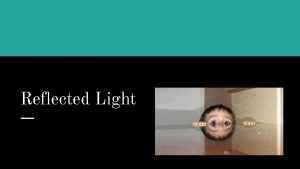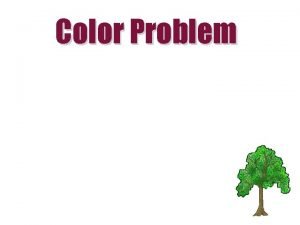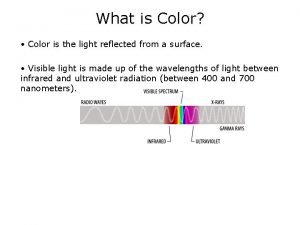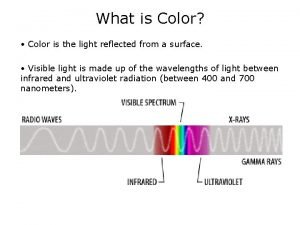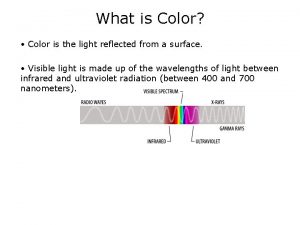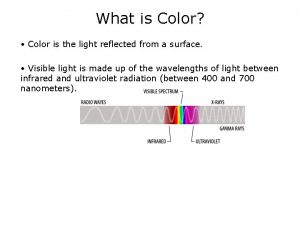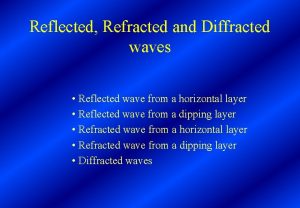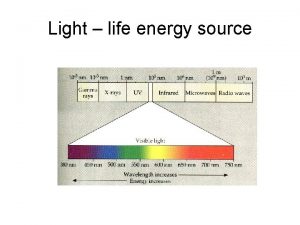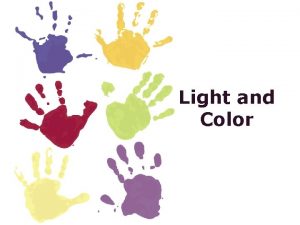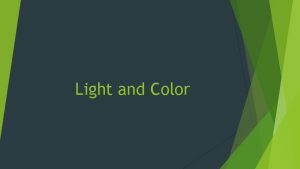What is Color Color is the light reflected




















- Slides: 20

What is Color? • Color is the light reflected from a surface. • Visible light is made up of the wavelengths of light between infrared and ultraviolet radiation (between 400 and 700 nanometers).

Forms of Light What do x-rays, sun tanning, the warmth from a candle, TVs, and radios all have in common? They are all forms of light. Some light you can see, and some light you cannot. The light you can't see includes x-rays and radio signals. Energy with wavelengths too short to see is "bluer than blue". Light with such short wavelengths is called "Ultraviolet" light. Energy with wavelengths too long to see is "redder than red". Light with such long wavelengths is called "Infrared" light. The term "Infra-" means "lower than".

Forms of Light The light you can see is called the visible spectrum. The visible spectrum is like a rainbow. Blue Light Because the blue wavelengths are shorter in the visible spectrum, they are scattered more efficiently by the molecules in the atmosphere. This causes the sky to appear blue. Green Light Grass appears green because all of the colors in the visible part of the spectrum are absorbed into the leaves of the grass except green. Green is reflected, therefore grass appears green.

Our eyes are sensitive to light which lies in a very small region of the electromagnetic spectrum labeled "visible light". This "visible light" corresponds to a wavelength range of 400 - 700 nanometers (nm) and a color range of violet through red. The human eye is not capable of "seeing" radiation with wavelengths outside the visible spectrum. The visible colors from shortest to longest wavelength are: violet, blue, green, yellow, orange, and red. Ultraviolet radiation has a shorter wavelength than the visible violet light. Infrared radiation has a longer wavelength than visible red light. White light is a mixture of the colors of the visible spectrum. Black is a total absence of light. Earth's most important energy source is the Sunlight consists of the entire electromagnetic spectrum.

Color Models Additive Model Subtractive Model RGB, Light CMYK, Pigment

Additive Model RGB, Light A representation of additive color mixing. Projection of primary color lights on a screen shows secondary colors where two overlap; the combination of all three of red, green, and blue in appropriate intensities makes white. http: //en. wikipedia. org/wiki/RGB_color_model

Subtractive Model CMYK, pigment The CMYK model works by partially or entirely masking colors on a lighter, usually white, background. The ink reduces the light that would otherwise be reflected. Such a model is called subtractive because inks “subtract” brightness from white. Layers of simulated glass show semi-transparent layers of color combine on paper into a spectrum of CMY colors. The CMYK color model (process color, four color) is a subtractive color model, used in color printing, and is also used to describe the printing process itself. CMYK refers to the four inks used in some color printing: cyan, magenta, yellow, and key or black. http: //en. wikipedia. org/wiki/RGB_color_model

Additive Color Sergei Mikhailovich Prokudin-Gorskii. Dmitrievskii Church, 1911.

Color Gamuts The Visible spectrum consists of billions of colors, a monitor can display millions, a high quality printer is only capable of producing thousands, and older computer systems may be limited to 216 cross-platform colors. Reproducing color can be problematic with regard to printed, digital media, because what we see is not what is possible to get. Although a monitor may be able to display 'true color' (16, 000 colors), millions of these colors are outside of the spectrum available to printers. Since digital designs are generated using the RGB color system, colors used in those designs must be part of the CMYK spectrum or they will not be reproduced with proper color rendering. Working within the CMYK color system, or choosing colors from Pantone© palettes insures proper color rendering. http: //www. worqx. com/color_systems. htm

Primary Colors Primary colors are the most basic colors; they cannot be broken down into component colors. The primary colors are different depending on which color model you are using. The primary colors in the Newtonian color model are red, yellow, and blue. Graphics taken from www. colormatters. com

Secondary Colors These are the colors formed by mixing the primary colors. Graphics taken from www. colormatters. com

Describing Color Hue The ‘color’ of the color. Red, Orange, Yellow, Green, Blue, Indigo, Violet Value Lightness (tint) or darkness (shade) of a color. Saturation (Chroma) Intensity of the hue in the color. Desaturated colors tend to look gray.

Color Relationships Primary Colors Secondary Colors Essential colors, cannot be broken down into component colors Mixture of two primary colors Analogous Colors located close together on a color wheel. Complementary Colors Located opposite each other on a color wheel Newtonian (Artist’s) Color Wheel Monochromatic Colors Shades and tints of the same color Shade and Tint Intensity Add black or white Amount of saturation) Graphics taken from www. worqx. com/color

Color Temperature can be measured absolutely, or relatively. For example, yellow-green is warmer than cyan-green, but both are cool colors. An approximate separation of absolute color temperature is denoted below: M R A W L O O C Nearly any color could appear as either warm or cold depending on the surrounding colors, especially those near the dividing line.

Newton’s Color Model A color circle, based on red, yellow and blue, is traditional in the field of art. Sir Isaac Newton developed the first circular diagram of colors in 1666. Graphics taken from www. colormatters. com

Tints, Tones and Shades of Hues HUES These are the purest and brightest colors. They form the full spectrum of colors which progress around the Primary Color Wheel in gradual increments. These color schemes are bold, cheerful and exciting. TINTS A Tint is sometimes called a Pastel. It's simply any color with white added. A color scheme using Tints is soft, youthful and soothing. SHADES A Shade is simply any color with black added. Shades are deep, powerful and mysterious. They work well in a masculine environment and are best used as dark accents. TONES A Tone is created by adding both white and black. Any color that is "greyed down" is considered a Tones are somehow more pleasing to the eye. They can be complex, subtle and sophisticated. Graphics taken from http: //www. color-wheel-artist. com/index. html

Johannes Itten From 1919 to 1922, Itten taught at the Bauhaus, developing the innovative "preliminary course” which was to teach students the basics of material characteristics, composition, and color. He also published a book, The Art of Color. Itten's so called "color sphere" went on to include 12 colors. http: //en. wikipedia. org/wiki/Johannes_Itten

Color Context and Josef Albers Red appears more brilliant against a black background and somewhat duller against the white background. In contrast with orange, the red appears lifeless; in contrast with blue-green, it exhibits brilliance. Notice that the red square appears larger on black than on other background colors. Josef Albers, also from the Bauhaus, discusses the relative nature of color in his book, Interaction of Color. Graphics taken from www. colormatters. com

Color Symbolism - 1 Natural Associations Psychological or Cultural Associations Color conveys meanings in two primary ways - natural associations and psychological symbolism. People are comfortable when colors remind them of similar things. For example, a soft shade of blue triggers associations with the sky and a psychological sense of calm. Successful design requires an awareness of how and why colors communicate meaning. The source of these meanings can be quite conspicuous, such as those found in nature — red is the color of blazing fire and blood, blue the color of cooling waters and the sky. Other meanings may be more complex and not universal. As a starting point, the communicative properties of a color can be defined by two categories: natural associations and psychological (or cultural) associations. Occurrences of colors in nature are universal and timeless. For example, the fact that green is the color of vegetation can be considered a universal and timeless association. Graphics taken from www. colormatters. com

Color Symbolism - 2 Natural Associations Psychological or Cultural Associations Color may generate another level of meaning in the mind. This symbolism arises from cultural and contemporary contexts. As such, it is not universal and may be unrelated to its natural associations. For example, green’s associations with nature communicate growth, fruitfulness, freshness and ecology. On the other hand, green may also be symbolic of good luck, seasickness, money and greed — all of which have nothing to do with green plants. These associations arise from a complex assortment of sources. Furthermore, color may have both positive and negative symbolism. For example, although blue is the beautiful color of the sky on a sunny day, it can be symbolic of sadness or stability. Idiomatic American English reflects these traits in phrases such as “singing the blues” and “blue chip stocks. ” Red is another example of dual symbolism. On one hand, as the color of fire and blood, it is an energizing, aggressive and bold color. In direct contrast, red is used for “STOP” signs throughout the world today. Graphics taken from www. colormatters. com
 The amount of light that is reflected depends on: *
The amount of light that is reflected depends on: * Colorter
Colorter An element of art that is derived from reflected light
An element of art that is derived from reflected light Light light light chapter 23
Light light light chapter 23 Into the light chapter 22
Into the light chapter 22 Light light light chapter 22
Light light light chapter 22 Reflected appraisal
Reflected appraisal Seven types of meaning by geoffrey leech
Seven types of meaning by geoffrey leech Reflected radiation formula
Reflected radiation formula Collocative meaning in semantics examples
Collocative meaning in semantics examples Refraction vs reflection
Refraction vs reflection Reflected appraisal
Reflected appraisal Reflected appraisal
Reflected appraisal Identity scripts
Identity scripts Write the business rules reflected in this erd.
Write the business rules reflected in this erd. Reflected radiation formula
Reflected radiation formula Which form of art reflected postwar uncertainty?
Which form of art reflected postwar uncertainty? To give up one's views
To give up one's views Reflected xss
Reflected xss Reflected xss
Reflected xss Mechanical wave interference
Mechanical wave interference
